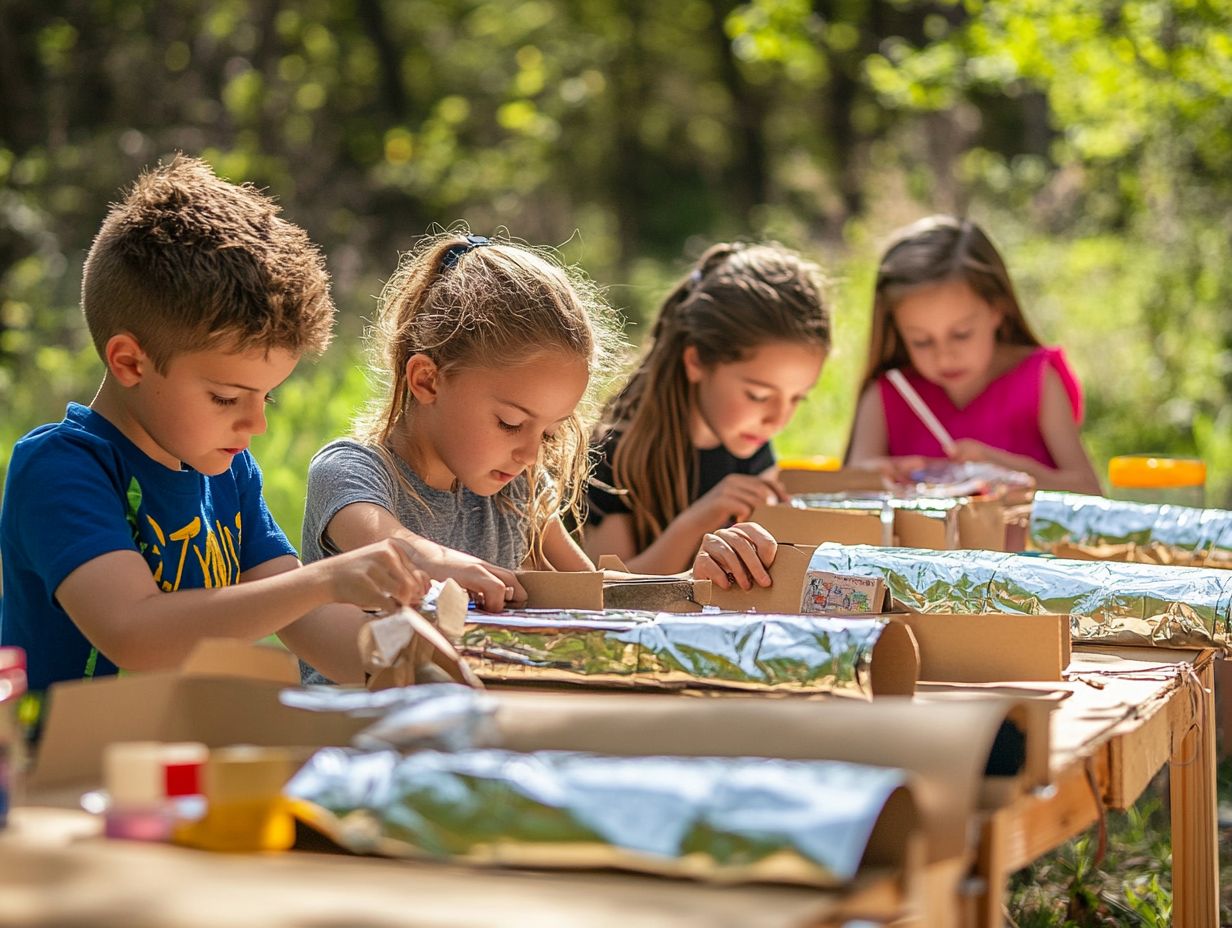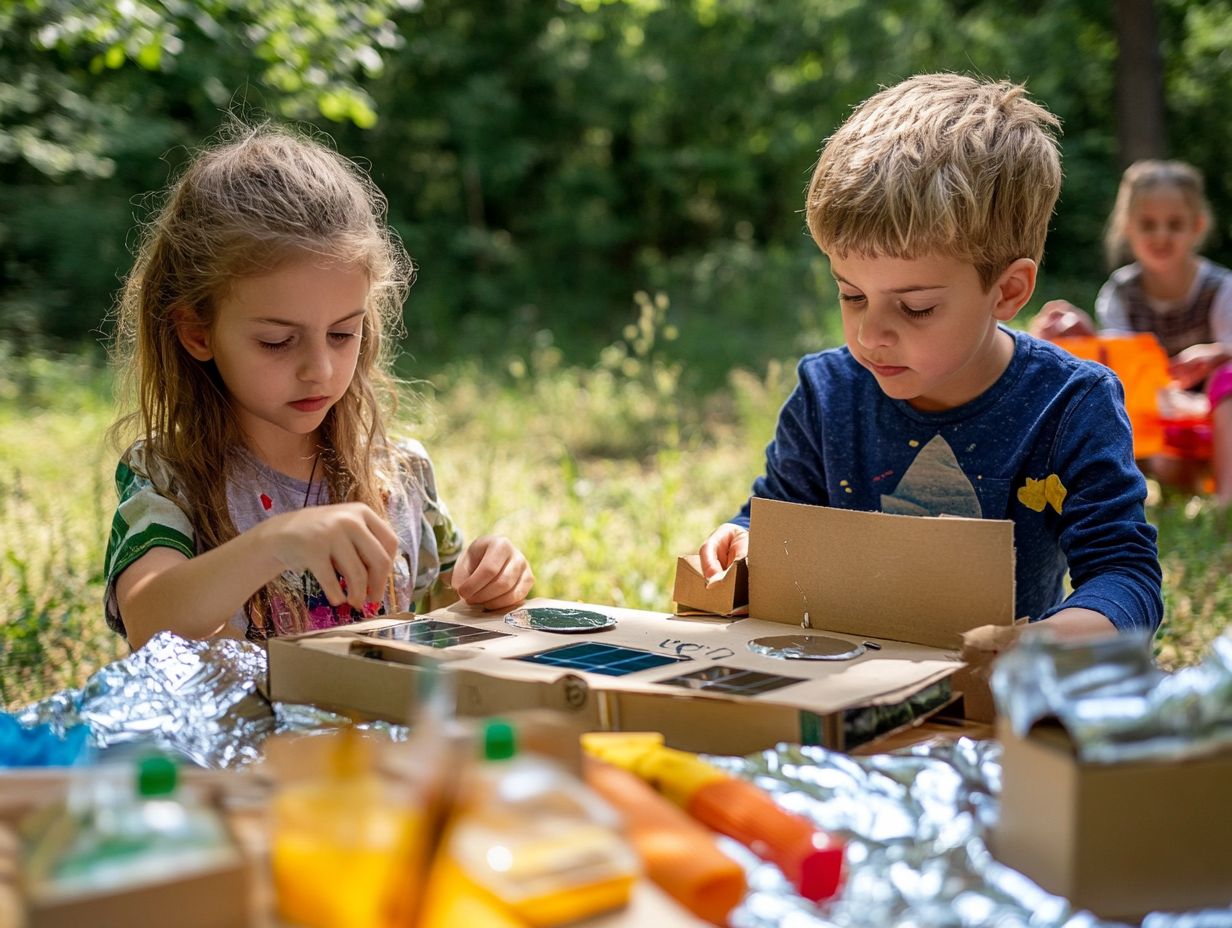Solar Energy Experiments
Solar energy is an abundant and sustainable resource that plays a crucial role in achieving a greener future!
This article explores fun solar energy experiments for kids, designed to spark scientific thinking and creativity.
Readers will discover the benefits of hands-on experiments, essential materials and equipment, and exciting project ideas such as building solar ovens, creating solar prints, and making solar-powered devices like a solar phone charger or a solar-powered car.
Whether you’re a student, educator, or just curious about science, these experiments will help you appreciate renewable energy and learn how to harness the sun’s power. They’re perfect for science fairs or solar summer camps!
What is Solar Energy?

Solar energy is the light and heat we capture from the sun. It can be turned into electricity or heat using technologies like solar panels and heaters. This energy helps reduce global consumption and combat climate change.
The field of Solar Science looks at ways to use solar energy efficiently, from large solar farms to small solar kits for homes. It’s a fascinating area, explored by authors like Carolyn Cinami DeCristofano and Laurie Brearley.
By learning about different types of solar energy, such as solar panels that convert sunlight into electricity or systems that use mirrors to gather solar heat, we can see how versatile it is for applications like heating water.
Solar energy is important not just for generating electricity; it also helps cut greenhouse gas emissions, boosts energy security, and supports sustainable development.
With ongoing advancements in solar technology, such as improved efficiency and better energy storage, the possibilities are endless! These innovations can power homes, businesses, and even electric vehicle charging stations, paving the way for a sustainable future.
Benefits of Conducting Solar Energy Experiments
- Engages kids with renewable energy concepts.
- Provides hands-on learning experiences.
- Boosts curiosity and critical thinking.
- Prepares students for science fairs and summer camps.
Conducting solar energy experiments offers kids a fun way to learn about renewable energy. They get to see how sunlight can be turned into usable energy!
These experiments are fantastic educational tools that promote curiosity and critical thinking. They also help prepare students for science fairs or summer camps focused on sustainable technologies.
By encouraging a scientific mindset, we inspire young innovators in solar science and renewable energy!
Educational and Practical Benefits
- Hands-on learning experience.
- Teaches experimentation and problem-solving.
- Enhances teamwork and communication skills.
- Fosters creativity and innovation.
- Develops critical thinking through project analysis.
Engaging in solar projects with solar kits provides educational and practical benefits for learners of all ages, especially children. These projects allow them to learn about renewable energy and fundamental science concepts.
Students enjoy these activities while developing valuable skills in experimentation and problem-solving. They can explore how sunlight can be turned into energy through projects like solar ovens and solar-powered devices.
Working together on these projects helps kids improve their teamwork skills as they communicate and share ideas—essential skills for any profession!
Solar energy experiments also spark creativity as students come up with innovative solutions to real-world problems. They learn about the importance of renewable resources while designing their projects.
As they create and test their solar-powered inventions, students sharpen their critical thinking skills by analyzing results and making adjustments based on their findings. This process prepares them for future challenges in science and technology careers.
Materials and Equipment Needed

To carry out solar energy experiments, gathering the right materials and equipment is essential. You might need items like a solar oven, solar heater, and common supplies for hands-on learning.
Reading solar energy books by authors like Allan Drummond and Catherine Daly can enhance your understanding. These resources guide you on how to create projects like solar ovens or solar-powered chargers.
Essential Supplies for Beginner Experiments
For beginners, essential supplies can often be found at home or in solar kits designed for educational purposes. These simple projects help kids learn about absorbing heat and turning sunlight into energy.
Common supplies for solar energy experiments include:
- Old glass jars
- Aluminum foil
- Clear plastic containers
These materials are perfect for making solar-powered devices like sun tea or solar prints. Solar kits usually include photovoltaic cells and connectors for structured experimentation.
Using these supplies helps kids grasp key concepts, such as the greenhouse effect and energy transformation!
Experiment Ideas for Beginners
Here are some engaging experimental ideas for beginners that clearly demonstrate solar energy principles:
- Solar oven
- Solar-powered car
- Solar still
These projects show how sunlight can be turned into usable energy and give kids a sense of accomplishment as they engage in hands-on scientific activities!
Solar Oven

A solar oven is a fantastic beginner project that shows how to absorb heat and cook using sunlight! With simple materials like cardboard and aluminum foil, anyone can create their own solar oven and experiment with cooking food using solar energy.
This exciting project offers hands-on learning and ignites curiosity about renewable energy sources. To make a basic solar oven, gather these materials:
- A box
- Aluminum foil
- Plastic wrap
- Black paper (great for absorbing heat)
To build the solar oven:
- Line the interior of the box with aluminum foil to reflect sunlight.
- Place black paper at the bottom to absorb heat.
- Cover the top with clear plastic to create a greenhouse effect.
Set the oven in a sunny spot for best results, especially in the afternoon when the sun is strongest! Understanding these principles enhances the cooking experience, such as making delicious sun tea.
Solar Powered Car
Creating a solar-powered car allows kids to learn about renewable energy and basic engineering as they design vehicles powered by sunlight! This hands-on project showcases the practical applications of solar energy.
Participants will need these materials:
- Solar panels
- Motors
- Wheels
- Durable chassis
Each component is crucial for the car’s function, like building solar cells! Planning the layout carefully maximizes efficiency and safety during construction.
Understanding how solar cells convert sunlight into energy deepens our appreciation for renewable resources. This creative project encourages critical thinking and teamwork, highlighting the importance of collaboration in engineering!
Solar Still
A solar still is a wonderful educational project that demonstrates how solar energy can purify water. This fun activity is perfect for kids and shows practical uses of solar energy.
To build a solar still, gather these basic materials:
- A shallow container
- Clear plastic wrap
- A cup for collecting distilled water
- Small weights or stones
Follow these steps to create a solar still:
- Put contaminated or salty water in the container.
- Cover it tightly with plastic wrap.
- Place a weight in the center to create a low point for condensation.
As the sun heats the water, it evaporates. The vapor condenses on the underside of the plastic and drips into the cup. This fun project teaches about evaporation and condensation while highlighting the potential of renewable energy to solve water scarcity issues!
Tips for a Successful Experiment

To ensure successful solar energy experiments for kids, it’s important to follow safety precautions and be ready to troubleshoot during the process. These experiments encourage scientific thinking, critical analysis, and problem-solving skills!
By creating a safe and effective learning environment, kids can engage more deeply with solar science and its practical applications, like building solar ovens or creating solar prints.
Safety Precautions, Troubleshooting, and Solar Kits
Always wear protective gear, such as goggles and gloves. Make sure to have good ventilation when using adhesives or other potentially harmful materials. Teach kids the proper use of tools to prevent injuries. Using solar kits can also ensure a safe and comprehensive learning experience!
- Wear protective gear (goggles and gloves).
- Ensure proper ventilation when using adhesives.
- Teach kids the correct use of tools.
Knowing how to troubleshoot can help solve problems during experiments. Teamwork encourages problem-solving and helps deepen understanding of how solar panels turn sunlight into electricity!
Final Thoughts, Next Steps, and Solar Summer Camps
Exploring solar energy through experiments not only engages kids but also inspires future sustainable projects! By fostering curiosity and hands-on experimentation, we can nurture a new generation of scientists and innovators.
Incorporating solar energy projects into classrooms allows students to actively seek solutions for a cleaner planet. These efforts can spark an interest in engineering and environmental science.
Educators and parents should support the exploration of solar energy by introducing books from authors like:
- Carolyn Cinami DeCristofano
- Laurie Brearley
- Allan Drummond
- Catherine Daly
This helps young minds think critically and creatively about energy!
Encouraging students to share their discoveries at science fairs and other events fosters collaboration and knowledge-sharing. This turns them into passionate advocates for renewable energy!
Let’s inspire the next generation to lead the charge toward sustainable living! Start your solar energy experiments today!





